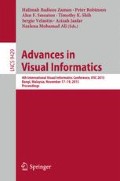Abstract
An application named “BTbrailleCal” based on Android smart phone is designed to help visually impaired students (VIS) in calculating numbers. This paper describes a user interface with an easy-to-distinguish layout that enables VIS to interact with touch screen on the smart phone. Vibration feedback and audio feedback will be provided to the user regarding their input. Additionally, the paper illustrates the Braille method specially details about math Braille. Paper prototypes are created at the beginning and then the final design is done by using the designing software “Pencil”. This educational application will assist the visually impaired students to solve their mathematical problems.
Access this chapter
Tax calculation will be finalised at checkout
Purchases are for personal use only
References
WHO Media Centre: Visual impairment and blindness. http://www.who.int/mediacentre/factsheets/fs282/en/
Mitra, S., Posarac, A., Vick, B.. Disability and poverty in developing countries: a snapshsot from the world health survey. World Bank Sp discussion paper 1109 (2011)
Rahman, K.F.: Blindness, ‘Vision 2020’ and Bangladesh. Financ. Express 20(436), 10 (2012)
Das, A.: Inclusion of student with disabilities in mainstream primary education of Bangladesh. J. Int. Dev. Cooperation 17(2), 1–10 (2011)
Braille, L.: Procedure for Writing Words, Music and Plain-song Using Dots for the Use of the Blind and Made Available to Them. Institute National des Jeunes Aveugles (Royal Institution Of Blind Youth), Paris (1829)
Southern, C., Clawson, J., Frey, B., Abowd, G.D., Romero, M.: An evaluation of brailletouch: mobile touch screen text entry for the visually impaired. In: 14th International Conference on Human-Computer Interaction with Mobile Devices and Services Companion (MobileHCI 2012), San Francisco (2012)
Kway, E.H., Salleh, N.M., Majid, R.A.: Slate and stylus: an alternative tool for Braille writing. Procedia Soc. Behav. Sci. 7, 326–335 (2010)
Tai, Z., Cheng, S., Verma, P., Zhai, Y.: Braille document recognition using belief propagation. J. Vis. Commun. Image Represent. 21(7), 722–730 (2010)
Yeh, F.H., Tsay, H.S., Liang, S.H.: Human computer interface and optimized electro-mechanical design for Chinese Braille display. Mech. Mach. Theor. 43(12), 1495–1518 (2008)
Ren, K., Liu, S., Lin, M., Wang, Y., Zhang, Q.M.: A compact electroactive polymer actuator suitable for refreshable Braille display. Sens. Actuators A Phys. 143(2), 335–342 (2008)
Yeh, F.H., Liang, S.H.: Mechanism design of the flapper actuator in Chinese Braille display. Sens. Actuators A Phys. 135(2), 680–689 (2007)
Kwon, H.J., Lee, S.W., Lee, S.S.: Braille dot display module with a PDMS membrane driven by a thermopneumatic actuator. Sens. Actuators A Phys. 154(2), 238–246 (2009)
Cheadle, B.: A parent’s guide to the slate and stylus. Future Reflections 13, 6–14 (1994)
Tang, J.: Using ontology and RFID to develop a new Chinese Braille learning platform for blind students. Expert Syst. Appl. 40, 2817–2827 (2013)
Halder, S., Hasnat, A., Khatun, A., Bhattacharjee, D., Nasipuri, M.: Development of a bangla character recognition (BCR) system for generation of Bengali text from Braille notation. Int. J. Innov. Technol. Exploring Eng. 3(1), 5–10 (2013)
Yousuf, M.A., Shams, S.M.S.: Bangla Braille information system: an affordable system for the sightless population. Asian J. inf. Technol. 6(6), 696–699 (2007)
Hossain, G., Asaduzzaman, M., Ullah, A., Shams, S.M.S.: Bangla Braille embosser: a tool for Bengli speaking blinds. In: IEEE 5th International Conference on Advance Learning Technologies, Washington, DC, USA (2005)
Nahar, L., Jaafar, A., Ahamed, E., Kaish, A.B.M.A.: Design of a Braille learning application for visually impaired students in Bangladesh. Assistive Technol. (ID: 1011758) (2015). doi:10.1080/10400435.2015.1011758
Harland, H., Roberts, C.: Unified English Braille for math. https://www.prcvi.org/files/braille/UEB_Braille_for_Math_2014.pdf
Saffer, D.: Prototyping interactive gestures. In: Designing Gestural Interfaces, 1st edn., pp. 117–138. Mary Treseler, O’Reilly Media Inc., Canada (2008)
Hugo, N., Montague, K., Guerreiro, T., Guerreiro, J., Hanson, V.L.: B#: chord-based correction for multitouch braille input. In: Proceedings of the 32nd Annual ACM Conference on Human Factors in Computing Systems, pp. 1705–1708. ACM, New York (2014)
Guerreiro, T., Nicolau, H., Jorge, J., Gonçalves, D.: NavTap: a long term study with excluded blind users. In: Proceedings of SIG ASSETS. AMC Press (2009)
Author information
Authors and Affiliations
Corresponding author
Editor information
Editors and Affiliations
Rights and permissions
Copyright information
© 2015 Springer International Publishing Switzerland
About this paper
Cite this paper
Nahar, L., Jaafar, A. (2015). Bangla Talking Calculator for Visually Impaired Students in Bangladesh. In: Badioze Zaman, H., et al. Advances in Visual Informatics. IVIC 2015. Lecture Notes in Computer Science(), vol 9429. Springer, Cham. https://doi.org/10.1007/978-3-319-25939-0_29
Download citation
DOI: https://doi.org/10.1007/978-3-319-25939-0_29
Published:
Publisher Name: Springer, Cham
Print ISBN: 978-3-319-25938-3
Online ISBN: 978-3-319-25939-0
eBook Packages: Computer ScienceComputer Science (R0)

